Items
Tag is exactly
health care
-
2021-04
Regret for a Trip Not Taken
This story is about travel that did not happen, but should have during the Covid-19 Pandemic. In mid-2020, my little sister Sarah was diagnosed with kidney cancer. She was married and had 3 children up in Seattle. When my family heard the news, travel was severely restricted and many people were still dying daily from the virus. I have my own wife and kids, so we all agreed that it wasn’t a good risk to go and visit. Besides, we reasoned, she hadn’t started treatment yet and she had good chances of beating cancer. So we waited it out. My sister and I talked frequently, and she told me that she was optimistic about her cancer diagnosis. Unfortunately, our Dad died in January of 2021 due to complications related to Covid (he had Parkinson’s also), and neither of us could travel to do any funeral service. In April of 2021, the pandemic had cleared up enough that most travel restrictions had ended, everyone was vaccinated, and the risk was lower. My older brother Sean had planned a trip to go to Seattle and stay there for a month to visit, help take care of kids and just be there. He urged me to go, at least for a week or so because he told me that he thought it wasn’t going as well with her treatments as Sarah had led me to believe. Because of Covid patients overwhelming hospitals, I don’t think she was getting as much good-quality medical care as she needed, though that’s my opinion. Anyway, I didn’t want to go on this trip. I don’t particularly handle death and dying well, and I didn’t want to go there and be basically sad and crying the whole time, and I was in denial about her health, so I didn’t go. A few months later, in June 2021, Sarah succumbed to cancer and died. If I could go back in time to do it over again, I definitely would have gone. I would have liked to walk around Seattle with her and take pictures to put on Facebook, our primary means of sharing memories, or take her kids out for a few hours to sight see and get to know them better. I regret, and always will, that I did not go and see her and her family there at the end. -
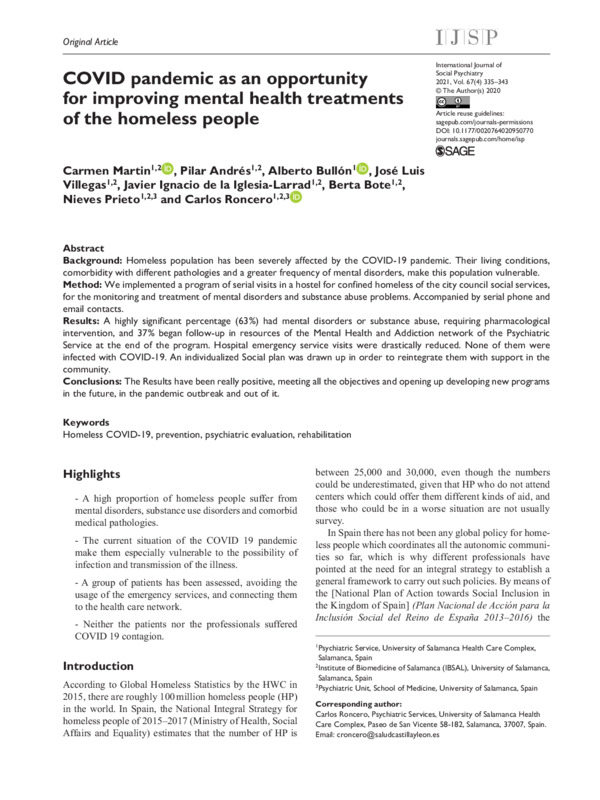 2021-06-27
2021-06-27Pandemic lockdown gives a new opportunity towards homeless mental health. A study from Spain
While the COVID-19 pandemic has drastically altered mental health, see https://covid-19archive.org/s/archive/page/mental-health, I hope that there could be benefits to mental health as COVID rates around the world drop. It is now more convenient than ever to partake in counseling services from the comfort of your room, especially if you have social anxiety or pandemic anxiety. Unfortunately, statistics are not out as of March 2022 that demonstrate that mental health is improving with waning COVID rates, instead counselors, psychiatrists, and psychologists seem busier than ever. While telehealth meetings are convenient, wait times and schedules are full of the backlog of people whose mental health was affected by the pandemic. I wanted to find an example of a positive outcome on mental health through COVID's global sweep, especially as COVID wanes. Attached is an example of a study in Spain that focused on a group of homeless in Spain that were in lockdown. "More than 60% of them presented mental disorders and within 8 weeks they were visited in person 2–3 times...Finally, 51.8% were linked to social and health care services and 37% to mental health resources, which can constitute a step forward in their reintegration and normalization." They argue that if it was not for COVID and these efforts, these homeless people may not have been diagnosed and helped. The paper concludes that this study is useful for the future because it shows how under immensely stressful situations, primary and secondary interventions worked. This can be repeated without a pandemic. While the pandemic was very stressful, it reaped some benefits such as a new focus on mental health, new methods of talking with trained professionals, and studied like this that show data of improving mental health in times of stress. -
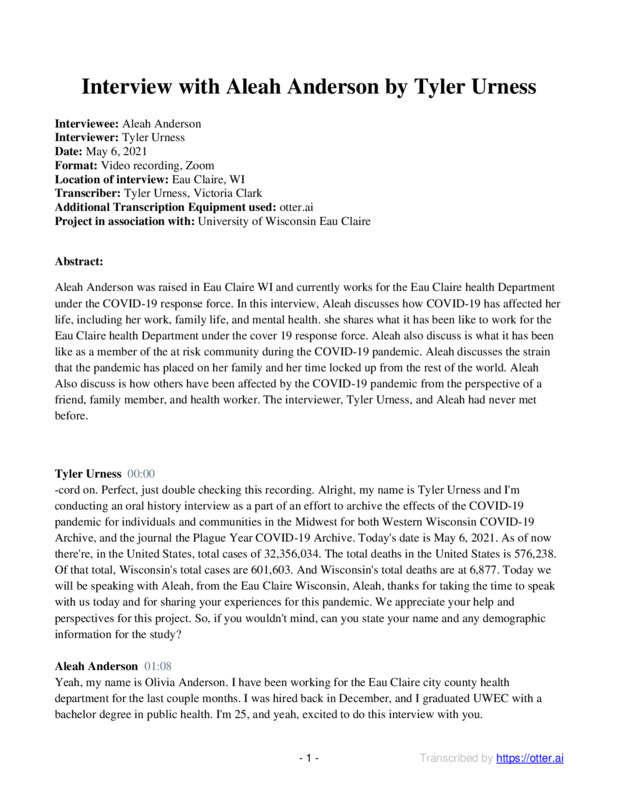 05/07/2021
05/07/2021Aleah Anderson Oral History, 2021/05/06
C19OH -
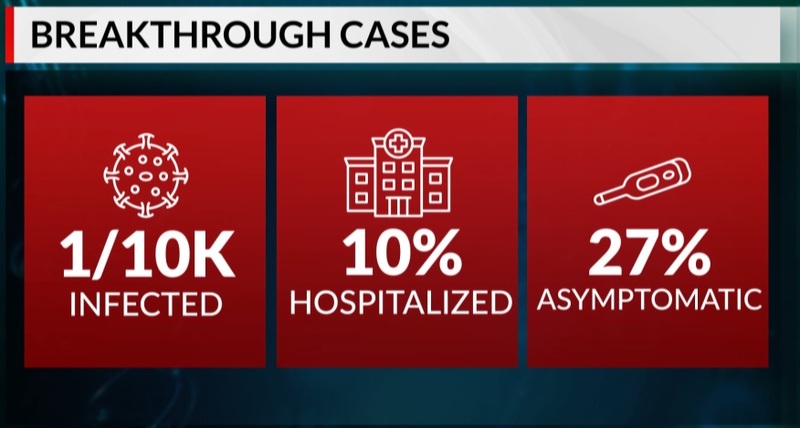 2021-05-25
2021-05-25Breakthrough COVID-19 cases possible but rarity shows vaccine effectiveness
This graphic shows the rates of infection and hospitalization for breakthrough infections for COVID-19 among vaccinated people (as of May 2021) -
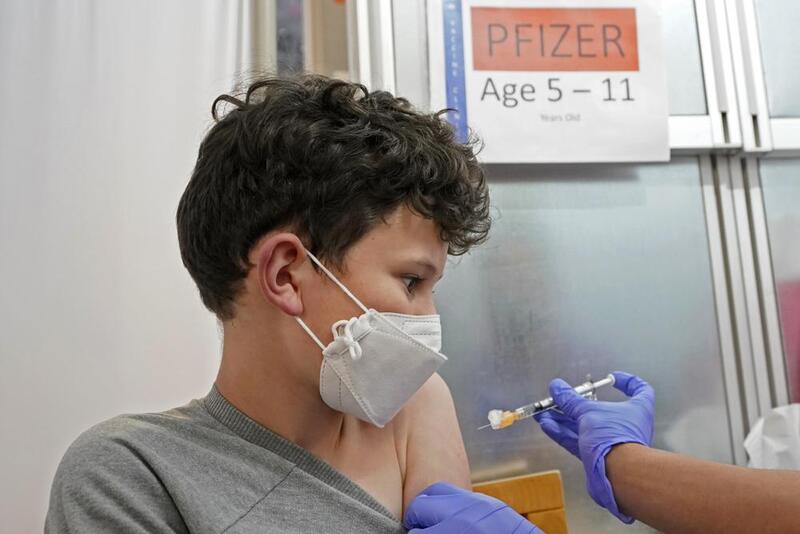 2021-11-10
2021-11-10Children Ages 5-11 Now Eligible for Vaccine
The campaign to vaccinate elementary school age children in the U.S. is off to a strong start, health officials said Wednesday, but experts say there are signs that it will be difficult to sustain the initial momentum. About 900,000 kids aged 5 to 11 will have received their first dose of the COVID-19 vaccine in their first week of eligibility, the White House said, providing the first glimpse at the pace of the school-aged vaccination campaign. “We’re off to a very strong start,” said White House COVID-19 coordinator Jeff Zients, during a briefing with reporters. Final clearance for the shots was granted by federal regulators on Nov. 2, with the first doses to kids beginning in some locations the following day. The estimated increase in vaccinations in elementary school age children appears similar to a jump seen in May, when adolescents ages 12 to 15 became eligible for shots. Now nearly 20,000 pharmacies, clinics and physicians’ offices are offering the doses to younger kids, and the Biden administration estimates that by the end of Wednesday more than 900,000 of the kid doses will have been given. On top of that, about 700,000 first-shot appointments are scheduled for the coming days. About 28 million 5 to 11 year-olds are now eligible for the low-dose Pfizer vaccine. Kids who get their first of two shots by the end of next week will be fully vaccinated by Christmas. The administration is encouraging schools to host vaccine clinics on site to make it even easier for kids to get shots. The White House is also asking schools to share information from “trusted messengers” like doctors and public health officials to combat misinformation around the vaccines. A initial surge in demand for vaccinations was expected from parents who have been waiting for the chance to protect their younger kids, especially before the holidays. About 3% of newly eligible children in the U.S. got first shots in the first week, but the rate of vaccinations in varied widely around the country, as it has for adult vaccines. California Health and Human Services Secretary Dr. Mark Ghaly said Wednesday that more than 110,000 Californians ages 5 to 11 have received their first coronavirus shot — 9% of kids that age in the state. “We are starting to see this pick up and I’m really encouraged about what this means for our state,” Ghaly said. On the other ends of the spectrum, Idaho reported just 2,257 first shots, or 1.3% of the newly eligible kids there. In West Virginia’s Cabell County, high demand led local health officials to start setting up vaccination clinics in all the county’s public middle schools. A spokeswoman for the county health department said there were some lines for vaccines in the first few days after the doses were approved for kids ages 5 to 11, but that things have slowed since then. Some experts say that nationally, demand could also begin to recede soon. They note polling data suggests only a fraction of parents have planned to get their kids shots immediately, and they suspect the trend will play out like it did earlier this year when kids ages 12 to 15 were first able to get shots. In the first week after vaccines for that age group were authorized in May, the number of adolescents getting a first shot jumped by roughly 900,000, according to an American Academy of Pediatrics review of federal data. The next week, it rose even further, to 1.6 million. “There was an initial burst,” said Shannon Stokley of the Centers for Disease Control and Prevention. But then the number dropped steadily for months, interrupted only briefly in early August as the delta variant surged and parents prepared to send children back to school. Adolescent vaccinations have since flagged considerably, to just 32,000 getting their first shots last week. Only about half of adolescents ages 12 to 17 are fully vaccinated, compared to 70% of adults. It’s unlikely that vaccination rates in young kids will be as high as what’s seen in adults — or even in adolescents, some experts said, unless they are required for school. Part of the reason is that adults are far more likely than children to suffer serious illness or die from COVID-19, they noted. “Parents may have the perception it may not be as serious in young children or they don’t transmit it,” said Stokley, the acting deputy director of the CDC’s Immunization Services Division. But more than 2 million COVID cases have been reported in U.S. children ages 5 to 11 since the pandemic started, including 66 deaths over the past year, according to CDC data. “We’re going to have a lot of work to do to communicate to parents about why it’s important to get children vaccinated,” she said. Zients said the effort to vaccinate younger kids is still ramping up, with new clinics coming on line. Government officials expect the number of children who are vaccinated to keep rising in the days and weeks ahead, he said. “We are just getting started,” he said. Earlier this year the White House set — and missed — a July 4 goal to have at least certain percentage of U.S. adults vaccinated. Officials have not announced a similar target for kids. Dr. Lee Savio Beers, president of the American Academy of Pediatrics, called the new numbers reassuring and said the rollout appears to be going smoothly for the most part. She noted however that with a lower dose and different vials than for older kids, the rollout requires more steps and that some states have been slower in getting vaccine to providers. Initial data from some areas show Black children lagging behind whites in getting their first doses, which Beers said raises concerns. “It’s really important to make sure the vaccine is easily accessible in a wide variety of places,” Beers said. -
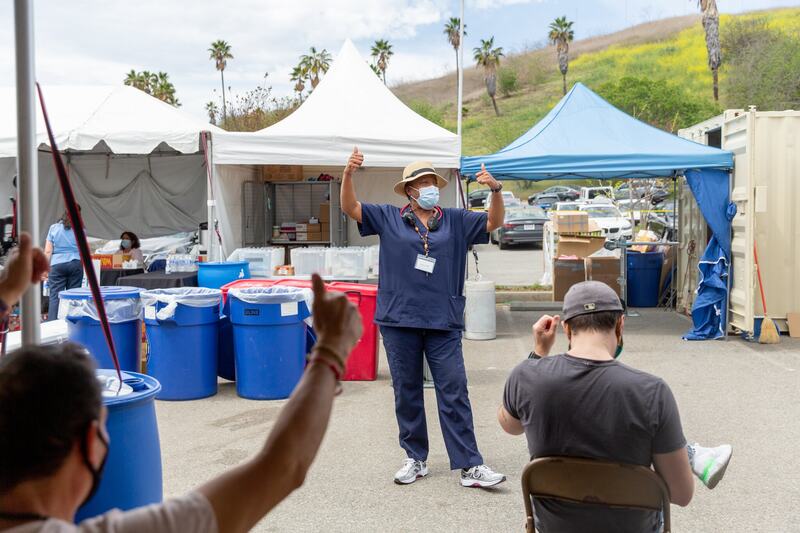 2021-04-06
2021-04-06Biden will offer a virus update as the pace of vaccination accelerates
President Biden will promote his administration’s success in accelerating the pace of coronavirus vaccinations during two appearances on Tuesday, as officials in nearly every state say they will make shots available to all adults by his target of April 19. Three months into his presidency, Mr. Biden confronts an escalating migrant surge at the border with Mexico and has embarked on a grind-it-out effort to ram through a $2.3 trillion infrastructure bill. But the virus remains his primary focus. And he wants the country to know that — so he is offering multiple updates each week, along with helpful visual cues, like standing next to a giant Easter bunny wearing a mask. On Tuesday afternoon, Mr. Biden will travel to Alexandria, Va., to tour a vaccination site at the Virginia Theological Seminary. Later, at the White House, he will deliver remarks emphasizing recent successes, including the milestone of delivering four million vaccinations in one day over the weekend. More than three million doses are now being given on average each day, compared with well under one million when Mr. Biden took office in January, according to the Centers for Disease Control and Prevention. Every state has now given at least one dose to a quarter or more of its population. About 62.4 million people — 19 percent of Americans — have been fully vaccinated. On Monday, Gov. Larry Hogan of Maryland announced that all Maryland residents 16 or older would be eligible from Tuesday for a shot at the state’s mass vaccination sites, and starting April 19 at any vaccine provider in the state. Also on Monday, Gov. Philip D. Murphy of New Jersey and Mayor Muriel Bowser of Washington, D.C., said residents 16 or older would be eligible on April 19. Gov. Kate Brown of Oregon announced Tuesday that all Oregonians over the age of 16 were eligible to receive a vaccine. The state had been limiting the doses to those with underlying conditions and frontline workers. That leaves one state, Hawaii, keeping to Mr. Biden’s original deadline of May 1. In Hawaii, 34 percent of residents have received at least one dose. Alabama has vaccinated the lowest proportion of its residents, at 25 percent. Along with dangerous coronavirus variants that were identified in Britain, South Africa and Brazil, new mutations have continued to pop up in the United States, from California to New York to Oregon. The shots will eventually win, scientists say, but because each infection gives the coronavirus a chance to evolve further, vaccinations must proceed as quickly as possible. For now, however, cases are rising sharply in parts of the country, with some states offering a stark reminder that the pandemic is far from over. Yet again, governors across the country have lifted precautions like mask mandates and capacity limits on businesses. -
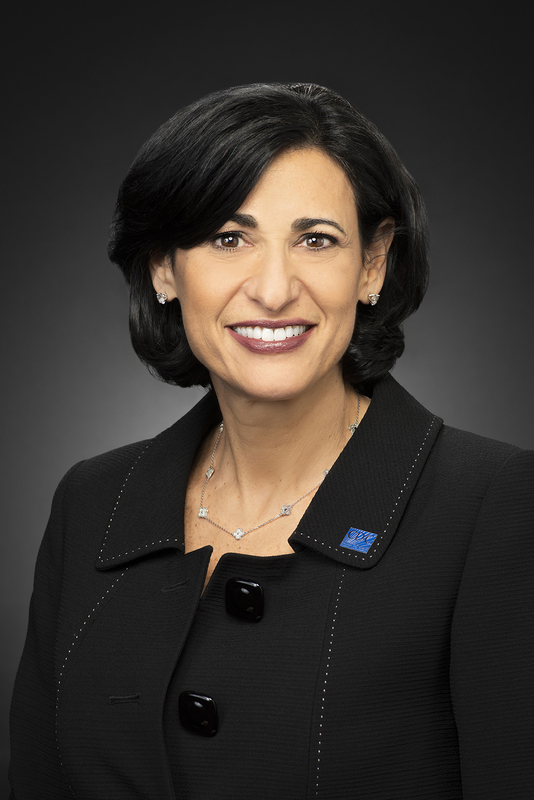 2021-01-19
2021-01-19Incoming CDC Director to Prioritize Communication, COVID-19 Vaccine Rollout
As Rochelle Walensky, MD, MPH, prepares to assume the role of CDC director on January 20, the former professor of medicine at Harvard Medical School and infectious disease physician at Massachusetts General Hospital and Brigham Women’s Hospital faces a myriad of challenges wrought by the ongoing coronavirus disease 2019 (COVID-19) pandemic. January 21st marks the 1-year mark since the first case of COVID-19 was reported in the United States, while current data indicate the country has surpassed 400,000 deaths. In comparison, the 1918 flu pandemic took 675,000 American lives, while the US reported a total of 405,000 fatalities during World War II. Even at the unprecedented speed with which pharmaceutical companies have developed vaccines for COVID-19, rollout has been fragmented at the state level while racial disparities in administration rates are beginning to become apparent. In an effort to improve the national rollout of COVID-19 vaccines, Walensky plans to increase the CDC’s communication to combat any hesitancy in receiving the vaccine, and indicated she wanted to increase media appearances above those made by current director Robert Redfield, MD, who departs with any remaining Trump administration officials Wednesday. She said making sure science-based communication is effectively disseminated to the public in layman’s terms is a top priority. “Science is now conveyed through Twitter. Science is conveyed on social media, on podcasts, and in many different ways. And I think that's critical,” Walensky said during a livestreamed interview with JAMA's Howard Bauchner, MD, the journal's editor-in-chief. When confronting vaccine hesitancy or anti-vaxxer sentiment on social media, “There's just this massive void and the right information, I think, is not getting out there… I want to make sure that the science is conveyed. We have to say it to one another. We have to say it to the public. And then we have to say it in other forms.” Internally, Walensky hopes to bolster the voices of scientists already employed by the CDC. Under the Trump presidency, “they have been diminished. I think they've been muzzled,” Walensky said. “This top tier agency—world renowned—hasn't really been appreciated over the last 4 years, and really markedly over the last year. So I have to fix that.” Although some states have been widely successful in administering the allotment of COVID-19 vaccines they were given, many have reported roadblocks. Part of the Biden administration’s plan to enhance rollout is to expand vaccine allocation to 4 key locations: federally qualified health centers, community vaccination centers (ie, stadiums), mobile units, and pharmacies. “Part of the challenge with COVID-19 was that we had a frail public health infrastructure to start. It wasn't ready to tackle what it was given,” Walensky said. As director, she hopes to bring this reality to Congress’ attention. “We're in this because we had warnings for many, many other public health scares in the last 20 years and we didn't fix our public health infrastructure and our data infrastructure,” in response to those tests. In order to meet President-elect Biden’s goal of 100 million vaccinations in 100 days, the constraints currently faced by federal and state governments need to be mitigated. “We have to titrate our supply and our eligibility so that we somehow hit the sweet spot, wherever it is we are, with how much supply we have and how many people are eligible,” Walensky said. While the CDC set the initial guidelines for vaccine eligibility and revised them this month, the Trump administration left actual rules and distribution processes to states, resulting in wide variation across the country. Some states adopted stricter standards that led to the waste of vaccines, while loose adherence has led to long lines and confused residents. Expanding the population of those eligible to administer the vaccine can also help alleviate these roadblocks. These individuals can include retirees, the Public Health Commissioned Corps, medical military, upper level medical and nursing students, dentists and veterinarians. Increasing both the number of vaccination sites and vaccinators will also help address the equity problems brought to light by the pandemic. “We want to make sure that we can deliver volume, but also volume to the people in places that might be harder to reach.” In a collaborative approach, the federal government will step in at a state-by-state level and offer help based on each state’s unique challenges, Walensky said. -
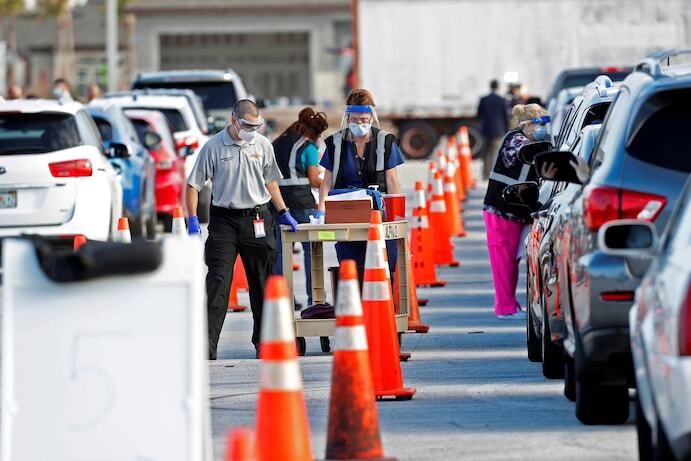 2020-12-31
2020-12-31Trump administration falls far short of vaccination goals as new virus variant looms
Logistical problems at the heart of the federal government’s faltering rollout of coronavirus vaccines came into sharper view Thursday as the Trump administration fell vastly short of its goal of delivering an initial shot to 20 million people by the end of December. On the final day of a bleak year, only about 2.8 million people had received the shot, according to the Centers for Disease Control and Prevention — the first of two doses needed to provide immunity to the virus. Around 14 million doses had been distributed as of Wednesday, according to Gustave Perna, chief operating officer of Operation Warp Speed, and a total of 20 million doses have been allocated. Though the figures are an underestimate — data collection on vaccinations has lagged — the doses administered so far represent just a small fraction of the ambitious targets outlined by officials from the administration’s Operation Warp Speed program in the fall. “We’d have liked to have seen it run smoothly and have 20 million doses in to people today, by the end of 2020, which was the projection,” Anthony S. Fauci, the government’s leading infectious-disease expert, said in an interview with NBC’s “Today” show on Thursday. “Obviously it didn’t happen, and that’s disappointing.” Nationwide, states and health-care providers continued to grapple with unpredictable timelines for when new vaccine shipments would arrive and in what quantities, while chronically underfunded public health departments struggled to muster the resources to carry out mass injections of front-line workers and vulnerable people. Fauci said that he hoped momentum for vaccinations would build in the first weeks of the new year and bring the country closer to its immunization goals. “But there really has to be more effort in the sense of resources for the locals, namely the states, the cities, the counties, the places where the vaccine is actually going into the arms of individuals,” he said. “We have to support the local groups, the states and the cities to help them get this task done, which is a very prodigious task.” Under the Trump administration’s plan, the federal government supplies vaccines to states but leaves it to state officials to prioritize residents, send doses to providers and get shots into people’s arms. The approach — as well as a litany of logistical problems — has caused a varied distribution effort. Local health departments and hospitals tasked with administering the vaccines have complained that they do not know when shipments will come or if they will receive additional resources, said Oscar Alleyne, and epidemiologist and chief of programs and services for the National Association of County and City Health Officials, which is made up of about 3,000 local health departments. “Some health departments have only received vaccines as recently as this week,” Alleyne told The Washington Post. “I had one health department that told me they had received their vaccines the day after Christmas.” Alleyne compared the communication concerns to those that cropped up during the H1N1 pandemic in 2009, when unclear guidance hampered efforts to get the population vaccinated. “It really boils down to ensuring a very transparent process,” Alleyne said. “There will always be a lag between the doses allocated and those shipped; between those shipped and those administered; and between those administered and those reported to CDC as administered,” Michael J. Pratt, a spokesperson for Operation Warp Speed, said in a statement. “We’re working to make those lags as small as possible.” At the Texas Medical Center, the largest medical complex in the world, the approach has already created logistical challenges. Hospital officials on the campus in south Houston often don’t know exactly when to expect new shipments or precisely how many vials they’ll receive, according to Bill McKeon, the center’s chief executive officer. That leaves the center with just a couple days’ worth of vaccine inventory on hand at a time, he said. “At best, we hear estimates. It’s a day-to-day situation,” McKeon told The Post. “We hear that we may be getting more next week but we’re not sure.” To date, the center has administered the first of the two injections to about 60,000 people, averaging more than 4,000 a day, according to McKeon. That includes some of the center’s 120,000 employees, as well as patients with underlying conditions who are first in line for inoculation. But it’s only a tiny portion of the sprawling metropolitan area the center serves. Until hospital officials can better predict how many vaccine doses they’ll have available week after week, McKeon said, vaccinating more people, faster, will be an uphill battle. “You can’t do scheduling with a couple days of inventory. We wouldn’t put a patient through the process of coming to the hospital, leaving their home, and then say, ‘Sorry we don’t have the inventory,’ ” he said. “We can’t be bold and just say, ‘Let’s do ten thousand a day.’ ” McKeon called on the federal government to take a more active role, possibly offering more large-scale vaccination centers, and relieve pressure on state officials, whom he said were “rowing in the same direction” as providers. There will be a growing need not just for more health-care workers to give the shots, he said, but for people who can perform the administrative work of calling patients, verifying their personal information and signing them up for injections. “I’m not seeing the grand strategies on a national basis, and I’m concerned, because this is a war,” he said. “Every day that we delay on some of those grander strategies we’re going to see losses of life.” As the distribution of vaccines has proceeded in fits and starts, coronavirus deaths and hospitalizations have soared to new heights. More than 125,000 people around the country were in hospital beds battling covid-19, the disease caused by the virus. Hospitalizations have exceeded 100,000 since Dec. 2. The nation on Wednesday also recorded a record 3,862 deaths in a day. The previous record, set on Dec. 17, was 3,406. New daily reported cases were trending upward again, after dipping during the week of Christmas. Family gatherings and spikes in holiday travel make it all but certain that the new year will bring yet another wave of infections. Compounding fears about the accelerating virus spread, a new, more transmissible variant of the coronavirus has cropped up in multiple U.S. states after circulating in the United Kingdom. The presence of the mutated pathogen only added to the need for vaccinations to ramp up quickly, said Scott Gottlieb, former Food and Drug Administration commissioner. “The Covid vaccine could be a tool to help reduce the impact of current wave of epidemic spread,” he tweeted Thursday. “But we’re largely missing the narrow window we had to deploy it rapidly enough to alter the present trajectory of death and disease in January. The new variant makes this more urgent.” Clarification: This story has been updated to cite Operation Warp Speed’s distribution numbers. It has also been updated to note that Operation Warp Speed has allocated 20 million vaccine doses to states. -
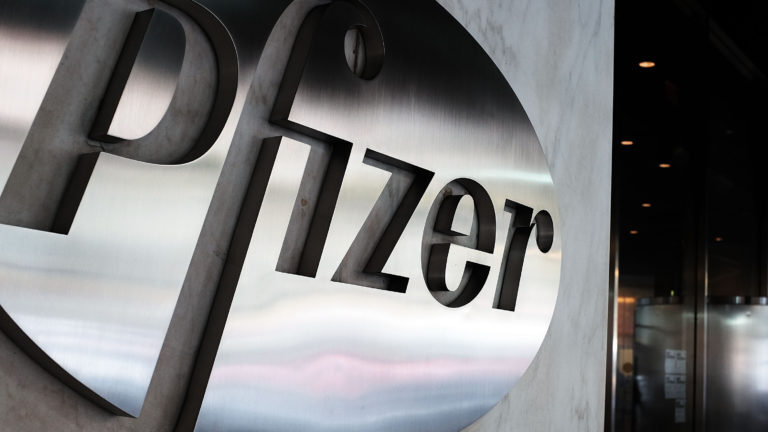 2020-09-14
2020-09-14Pfizer and BioNTech announce plan to expand Covid-19 vaccine trial
Pfizer and BioNTech are moving to enlarge the Phase 3 trial of their Covid-19 vaccine by 50%, which could allow the companies to collect more safety and efficacy data and to increase the diversity of the study’s participants. The companies said in a press release that they would increase the size of the study to 44,000 participants, up from an initial recruitment goal of 30,000 individuals. The U.S. Food and Drug Administration will have to approve the change before it goes into effect. “The companies continue to expect that a conclusive readout on efficacy is likely by the end of October,” the press release said. The Pfizer and BioNTech study is likely to be among the first in the U.S. to report efficacy data from a Phase 3 trial. Related: AstraZeneca resumes Covid-19 vaccine trials in the U.K. Expanding the trial will likely make it easier for the company to demonstrate whether the vaccine is effective against SARS-CoV-2, the virus that causes Covid-19. The companies also said that the change will allow the study to include a more diverse population. The companies said the study will now include adolescents as young as 16, people with stable HIV, and those with hepatitis C or hepatitis B. The companies said that the trial is expected to reach its initial target of 30,000 patients next week. Moderna, which started its trial on the same day as Pfizer, said on Sept. 4 that it is working to increase the diversity of trial participants in its study, “even if those efforts impact the speed of enrollment.” Related: Covid-19 Drugs and Vaccines Tracker The Pfizer/BioNTech study could finish sooner than Moderna’s, even though the two began on the same day, for other reasons, as well. Both vaccines require a second shot; Pfizer’s is given after three weeks, while Moderna’s is given after four. The Pfizer trial also starts to count cases of Covid-19 sooner after participants receive their shots than the Moderna study. But the Pfizer/BioNTech vaccine could also prove to be one of the most difficult of the experimental vaccines to distribute, should they prove effective. The vaccine must be kept at a temperature of -70 degrees Celsius. There has been political pressure to move a vaccine quickly, with President Trump saying that one could be available before election day. Last week, several drugmakers, including Pfizer, issued a pledge not to move a vaccine forward sooner than was justified by the results of their clinical trials. -
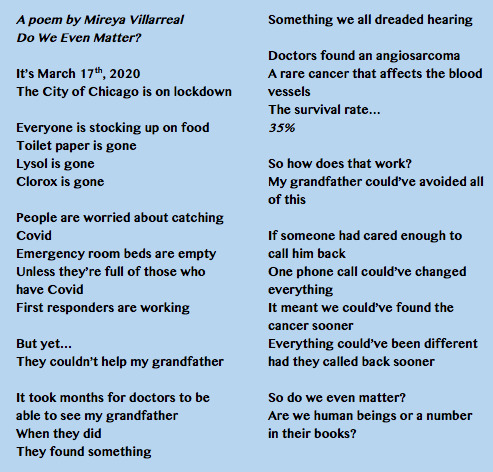 2021-10-26
2021-10-26Do We Even Matter?
This poem talks about the failure of our medical field when it came to covid. They focused more on those with Covid than those who were struggling with cancer. My grandfather became one of those victims. -
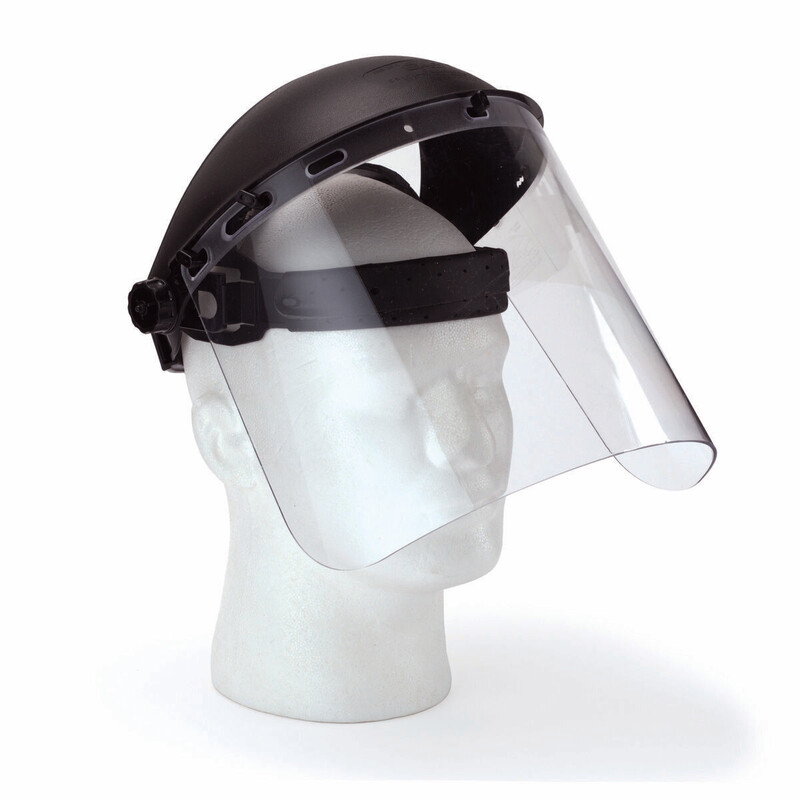 2021-10-14T19:40
2021-10-14T19:40The Clonky Helmet
I personally worked as a COVID 19 screener for South Texas Veterans Affairs. During that time we as COVID screeners were required to wear face shields and masks on our face for more than eight hours a day. After reading the article I posted from the CDC -- it now does not seem like it was a requirement at all for health workers to wear the face shields. I preferred to wear the ones that were much lighter. They were also face shields, but they were not in a shape of a helmet, they were lighter, and easier to handle as we screeners went from one job station to another. During the pandemic, while employed as a COVID 19 screener-- if we were caught without wearing the helmet (face shield) our jobs were threatened. We were only allowed to take the face shields off intermittently, for example, while at lunch. -
2021-10-15
Tense and Tempestuous Tones
In the year 2020, I was a medical assistant working for a cancer surgery clinic. The pandemic posed huge challenges for people working in healthcare and created new staggering standards for cleanliness and infection control. With limited personal protective equipment and cleaning supplies, it made everyday clinic operations very challenging. With cancer patients, most of whom were undergoing treatments that lowered their immune system, and many of whom had just had surgery which can increase risk of infection, medical staff took COVID safety precautions very seriously. Dealing with people battling illness can be challenging under normal circumstances because they are often feeling emotional and scared, but during COVID, tensions were running even higher. I will never forget patients using condescending, edgy, and outright angry tones with me when I would call for a COVID symptom screening prior to their appointment, inform them that they had to wear a mask at all times while in the clinic, or that they were unable to bring a family member to the exam room during a follow-up appointment with a doctor. Over the phone and in person, many patients used tense and tempestuous tones to take out their anger over a situation none of us had any control over. Often, there were political connotations to any discussion of clinic COVID policy, which was unusual in a conversation about infection control. Many patients would protest getting their temperature taken or question the accuracy of their oximetry reading (a started part of vitals even before the pandemic). It was always a relief to have a patient who took a dignified breath and calmly understood that the rules were in place for everyone's safety and were an inconvenience to all involved. There were several days where I would go off to an empty exam room during my lunch break and cry. Tension during the first year of the COVID pandemic was audible. -
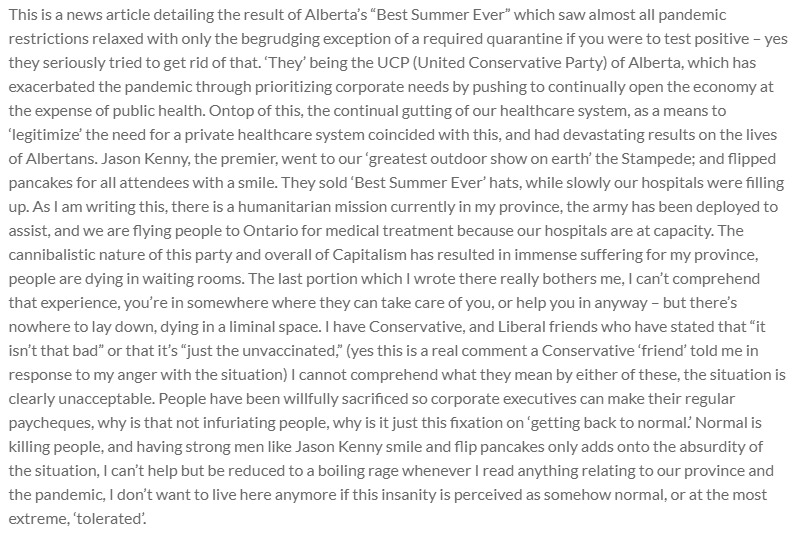 2021-09-24
2021-09-24Best Summer Ever
This is a news article detailing the result of Alberta’s “Best Summer Ever” which saw almost all pandemic restrictions relaxed with only the begrudging exception of a required quarantine if you were to test positive – yes they seriously tried to get rid of that. ‘They’ being the UCP (United Conservative Party) of Alberta, which has exacerbated the pandemic through prioritizing corporate needs by pushing to continually open the economy at the expense of public health. Ontop of this, the continual gutting of our healthcare system, as a means to ‘legitimize’ the need for a private healthcare system coincided with this, and had devastating results on the lives of Albertans. Jason Kenny, the premier, went to our ‘greatest outdoor show on earth’ the Stampede; and flipped pancakes for all attendees with a smile. They sold ‘Best Summer Ever’ hats, while slowly our hospitals were filling up. As I am writing this, there is a humanitarian mission currently in my province, the army has been deployed to assist, and we are flying people to Ontario for medical treatment because our hospitals are at capacity. The cannibalistic nature of this party and overall of Capitalism has resulted in immense suffering for my province, people are dying in waiting rooms. The last portion which I wrote there really bothers me, I can’t comprehend that experience, you’re in somewhere where they can take care of you, or help you in anyway – but there’s nowhere to lay down, dying in a liminal space. I have Conservative, and Liberal friends who have stated that “it isn’t that bad” or that it’s “just the unvaccinated,” (yes this is a real comment a Conservative ‘friend’ told me in response to my anger with the situation) I cannot comprehend what they mean by either of these, the situation is clearly unacceptable. People have been willfully sacrificed so corporate executives can make their regular paycheques, why is that not infuriating people, why is it just this fixation on ‘getting back to normal.’ Normal is killing people, and having strong men like Jason Kenny smile and flip pancakes only adds onto the absurdity of the situation, I can’t help but be reduced to a boiling rage whenever I read anything relating to our province and the pandemic, I don’t want to live here anymore if this insanity is perceived as somehow normal, or at the most extreme, ‘tolerated’. -
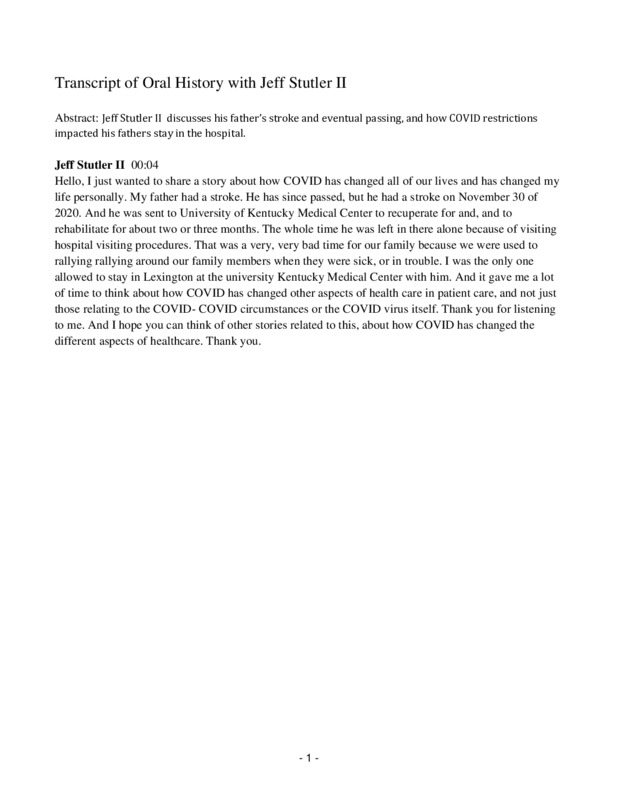 2020-12-01
2020-12-01Jeff Stutler II Oral History, 2020/12/01
This is an audio recording about my family's challenges in being with my father when he had a stroke in December of 2020. Forced distancing during family emergencies can be quite a scary experience. -
2020-03
Recollections from an Oncology Nurse
My mom is an oncology nurse and has worked in the field of nursing for the past 30 years. I recently asked her to talk to me about her experience this past year as a healthcare worker. She recalled the first week in March when things were becoming intense. People were asked to wear face shields and gowns as they were working in an immune-compromised area where the patients had cancer. At the time there was no vaccine. “It was incredibly intense and scary” my mother said. “People were worried about getting Covid from other staff at the hospital and also worried about contracting Covid from the patients.” “I walked into the hospital and there was an incredible underlying anxiety, the feeling of unease was palpable. People did not talk to each other like they normally did - everyone was consumed with the thought of not using each other’s pens, putting gloves on when receiving things from the pharmacy. Things we would never have even thought of before.” She continued, “It was a feeling of both being unsettled and a blind trust you put in your coworkers to be as clean, as responsible and in isolation outside of work as you. The intensity of that feeling was there the moment you walked in. The environment had changed. People were not as happy, communicative, relaxed.” She explained how working in Covid - there was an incredible newness to it - a fear and apprehension. -
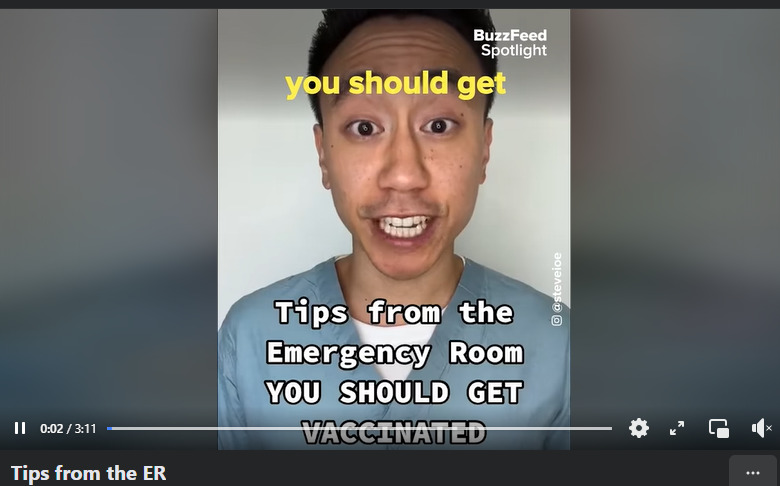 2021-08-04
2021-08-04Tips from the ER
Steve is a retired ER tech who has combined comedy with medical advice. In this clip, he uses humor to break down why being vaccinated is better than avoiding the vaccine even though it is still possible to contract the covid virus. -
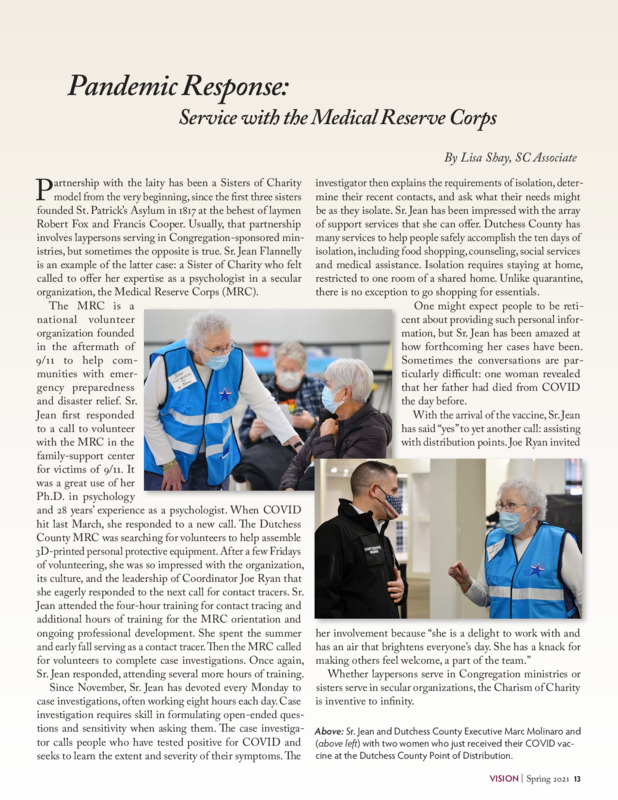 2021-03-02
2021-03-02A Religious Sister’s Service with the Medical Reserve Corps
This article celebrates the dedication of a friend and mentor, Sister Jean Flannelly, SC, who, at age 80, volunteered to serve with the Dutchess County New York Medical Reserve Corps to help people affected by the pandemic. Despite age and some health problems, she felt called to use her many talents as a psychologist, teacher, counselor and religious sister to do contact tracing, case investigation and serve in various roles at COVID-19 vaccination sites. She is an inspiration to me and to many! -
2021-08-06
Bruh Momo
The start of Covid really hitting was about February of 2020. We all went in cheerful for the new year but all it brought was plague. Covid only started a little before 2020 I think, my dad, friends, and myself all ended up getting sick around the end of 2019, probably about December or sooner when it was starting to get cold. The first things they did was give me medicine for pink eye, from my eyes being pink and veiny. Besides for that I didn´t really feel bad at all, i just had a cough that would kick in every so often, usually after activities. That all ended about two weeks into taking medicine and nasal drops. -
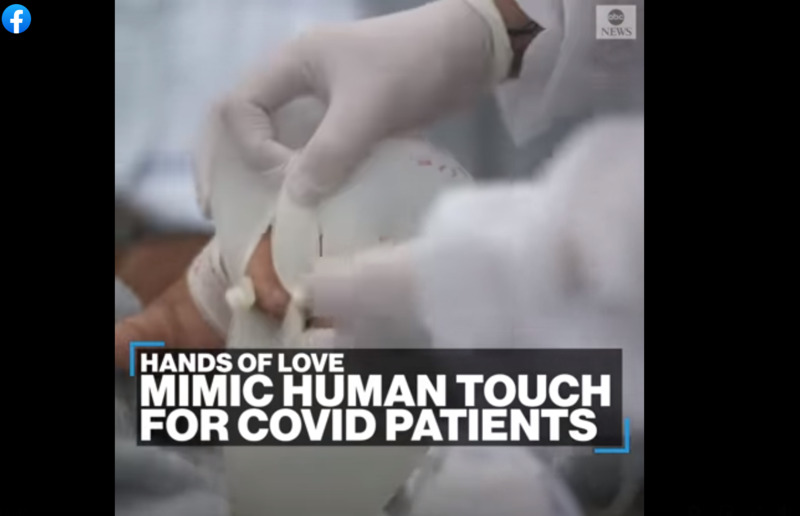 2021-04-21
2021-04-21Hands of love help COVID-19 patients in hospital
HANDS OF LOVE: Nurses fill latex gloves with warm water in a technique called "little hands of love" to help COVID-19 patients in intensive care beat isolation and stimulate blood flow. -
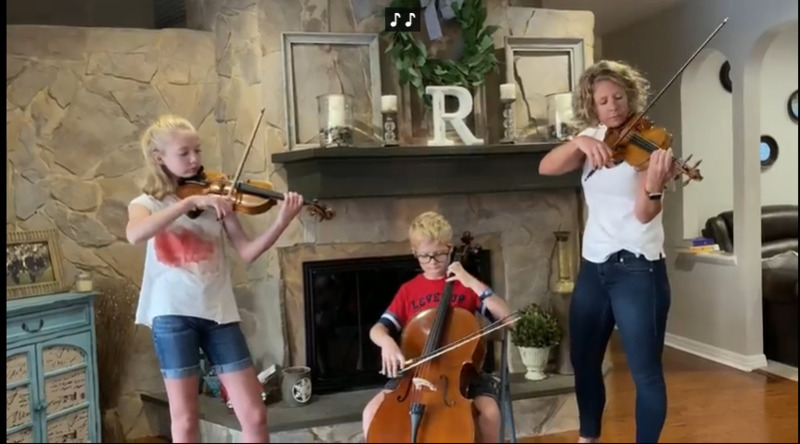 2021-04-03
2021-04-03COVID through a healthcare worker [PRIVATE Anonymous]
Working through a pandemic as a healthcare worker was terrifying. At the very beginning there were a lot of unknowns, and I felt lost, and alone. As I would go through my shifts as a CNA I had to be strong for my patients. I realized I would be going home to my family, but they were not. I was their "visitor" for the day. Patients could not just go outside for fresh air or wonder the halls to stretch their legs, they were confined to their room. Working in the hospital during this pandemic gave me a different perspective. While there were really hard days, there were also really great days. One of the best days was seeing a COVID recovered patient walk for the first time in months. It was times like this that made me realize that you are not granted tomorrow, and to enjoy each day to the fullest. I am so grateful for all the nurses, doctors, environmental services, secretaries, physical therapists, occupational therapists, case managers, and social workers who all came together to help our patients get through a challenging time. The song "Better Days" gives people hope that change and "better days" are near. The music video shows clips of people from all over the world and the impact this pandemic has on them. -
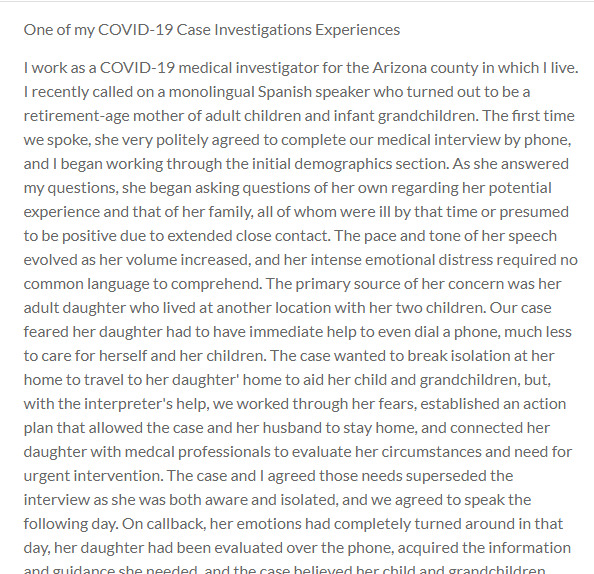 2021-02-15
2021-02-15One of my COVID-19 Case Investigations Experiences
I work as a COVID-19 medical investigator for the Arizona county in which I live. I recently called on a monolingual Spanish speaker who turned out to be a retirement-age mother of adult children and infant grandchildren. The first time we spoke, she very politely agreed to complete our medical interview by phone, and I began working through the initial demographics section. As she answered my questions, she began asking questions of her own regarding her potential experience and that of her family, all of whom were ill by that time or presumed to be positive due to extended close contact. The pace and tone of her speech evolved as her volume increased, and her intense emotional distress required no common language to comprehend. The primary source of her concern was her adult daughter who lived at another location with her two children. Our case feared her daughter had to have immediate help to even dial a phone, much less to care for herself and her children. The case wanted to break isolation at her home to travel to her daughter' home to aid her child and grandchildren, but, with the interpreter's help, we worked through her fears, established an action plan that allowed the case and her husband to stay home, and connected her daughter with medcal professionals to evaluate her circumstances and need for urgent intervention. The case and I agreed those needs superseded the interview as she was both aware and isolated, and we agreed to speak the following day. On callback, her emotions had completely turned around in that day, her daughter had been evaluated over the phone, acquired the information and guidance she needed, and the case believed her child and grandchildren were now safe and well. Throughout the roughly 90-minute translated interview, she repeatedly expressed her gratitude for our having called and helped her family and information and guidance. Despite the number of times our patients/cases have expressed anger, outrage, suspicion, or worse at our medical investigation and contact tracing efforts, this series of calls made them worthwhile. -
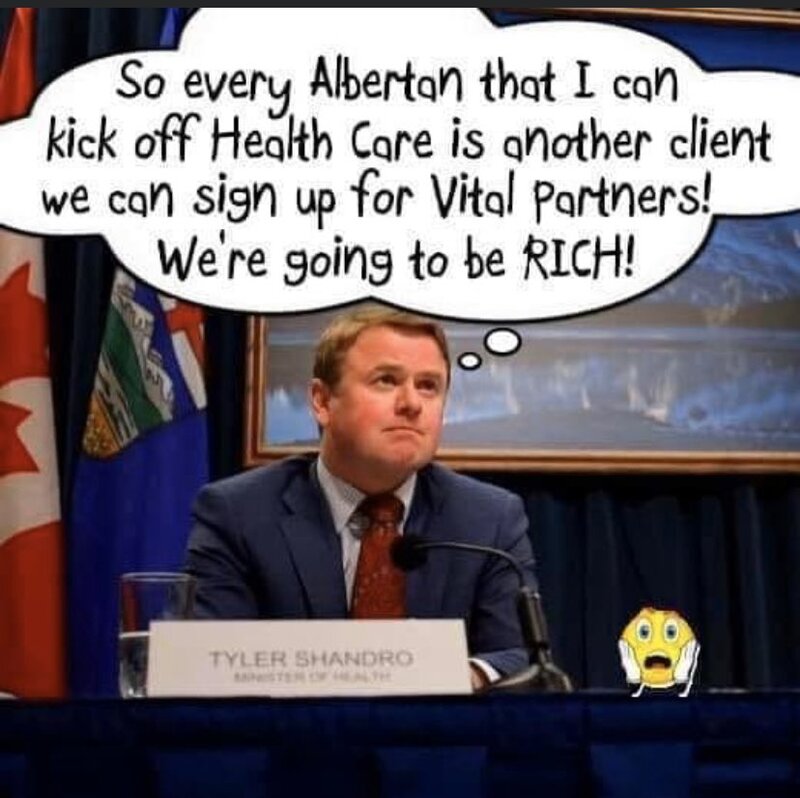 2020
2020Tyler Shandro
A meme depicting Alberta Health Minister Tyler Shandro thinking of the amount of money he can make from kicking people off health care and signing them up for Vital Partners -
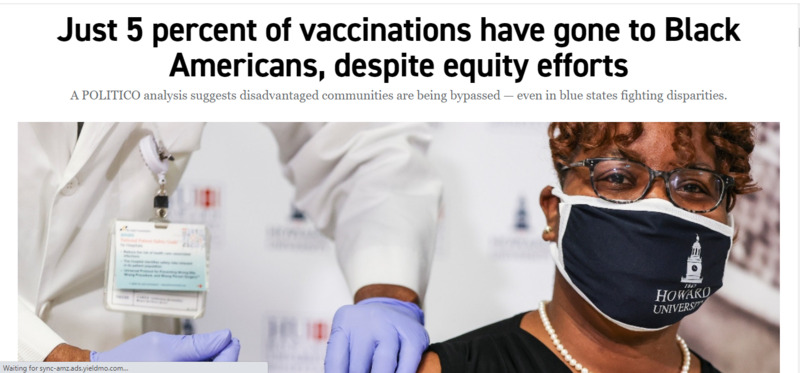 2021-02-01
2021-02-01Just 5 percent of vaccinations have gone to Black Americans, despite equity efforts
An article discussing how racial disparities can be viewed in regards to Black communities and the coronavirus. -
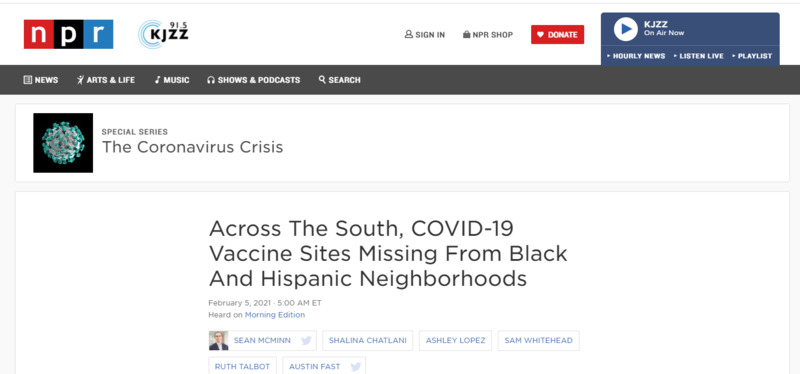 2021-02-05
2021-02-05Across The South, COVID-19 Vaccine Sites Missing From Black And Hispanic Neighborhoods
An article and short podcast discussing how difficult it is to get vaccinated in Black neighborhoods, mostly due to lack of vaccinations and locations. -
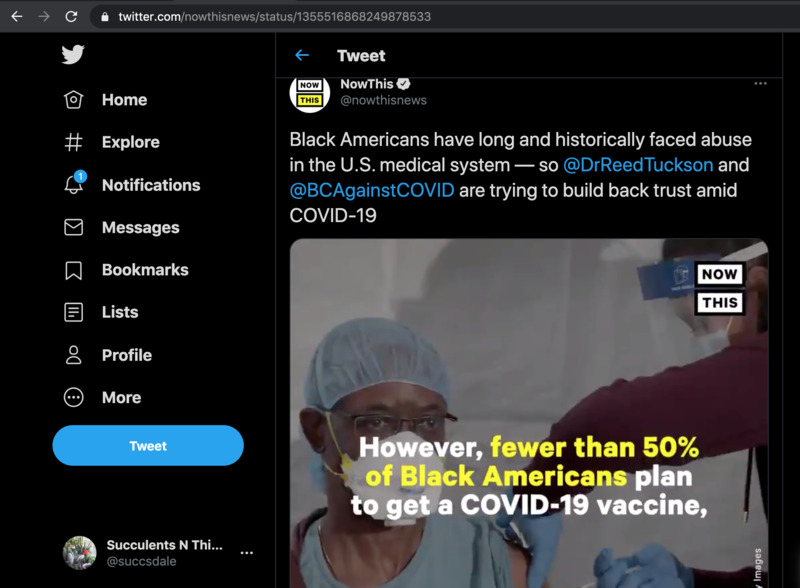 2021-02-28
2021-02-28Building Trust in the Vaccine
When I was pregnant and going to birthing classes, I learned the terrifying rates of mortality for Black women giving birth. The numbers were horrifying, so there is no wonder to me why a high percentage of Black Americans do not plan on getting the COVID-19 vaccine. The American healthcare system has failed them. But a group of Black doctors are standing up to tell their communities that not taking the vaccine is to risk their life, and they deserve better. This video, shared to NowThisNews on twitter, describes what the doctors' message is and why it is so important. Black lives do matter, which is why these doctors are urging everyone to get the vaccine. The video states that more Black Americans have died from COVID than any other ethnic group. Hopefully, the vaccine will stop these deaths. -
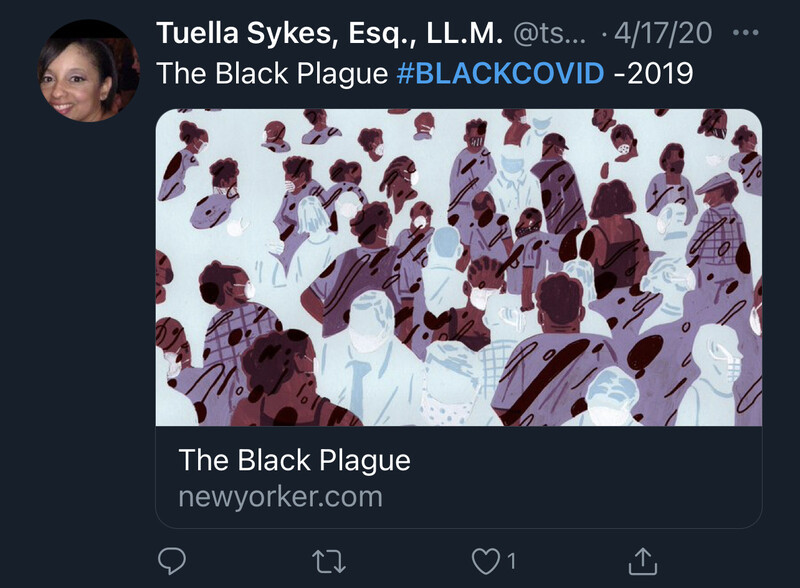 2021-02-22
2021-02-22Black history and the COVID-19 pandemic
This post tags an article titled "The Black Plague" which states that according to the Reuters report African Americans are more likely to die from Covid-19 than any other group in the U.S.. The article goes further in to explain the synopsis of affected and deaths of certain states but it importantly states that black people are more likely to have pre-existing health conditions that weaken their immune systems causing them to be easily infected. Though this is one reason why; other reasons including, as stated in the article "Trumpanian Malfeseance" is another major cause. With the testing locations around the U.S having major breakpoints, it was noted that zipcodes of higher-income families had the closest and many available sights of getting tested compared to zip codes with low-income families. Further studies showed that out of these lower-income locations, the majority was filled by black people. This limited the opportunity for black people to get tested and explains how the pandemic is affecting black people. -
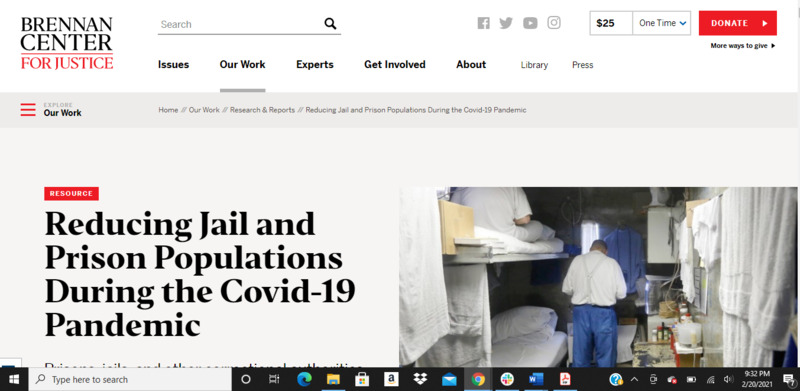 2021-02-05
2021-02-05Reducing Jail Sentences for Inmates with Preexisting Health Conditions
The study conducted by the Brennan Center for Justice (BCJ) found that prisons, jails, and detention facilities are rushing to make an effort to release unnecessarily incarcerated people to improve healthcare and conditions of confinement for the remaining inmate population. As part of a larger project to end mass incarceration, the BCJ analyzed the unique health challenges posed by the inmate population both 65 and older, as well as those with preexisting medical conditions. "Brennan Center Recommendation: Elderly and sick people and those incarcerated for parole violations should be released or recommended for release under compassionate release provisions or another authority. Barring that, prison officials should use their discretion to transfer people to community corrections options." -
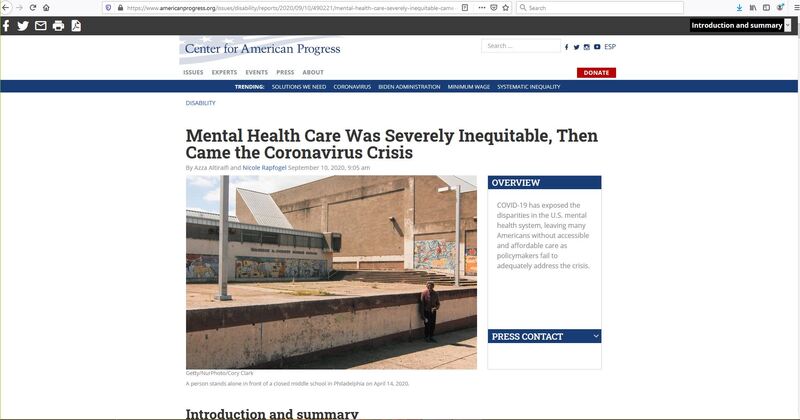 2020-09-10
2020-09-10Mental Health Care Was Severely Inequitable, Then Came the Coronavirus Crisis
This article describes how the Covid-19 pandemic has compounded the mental health disparity in the United States. As the title suggests, those suffering from mental illness already did not receive equitable treatment; the pandemic has widened this inequality through a variety of issues, chiefly, disruption of service that was already minimal. -
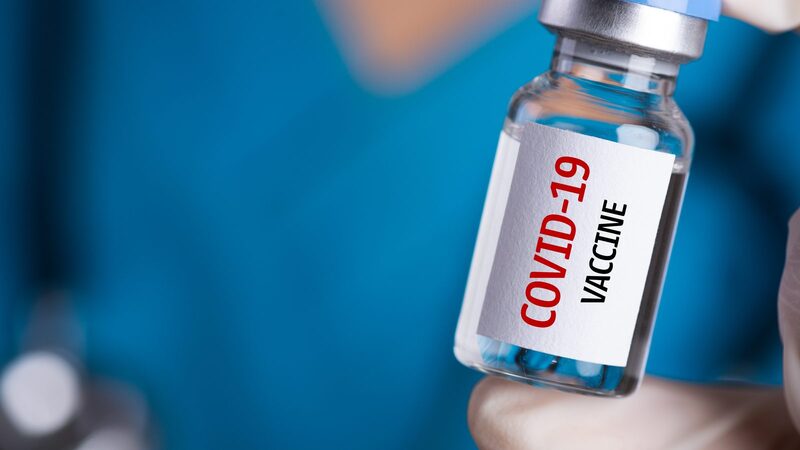 2021-01-23
2021-01-23Change of Life A Friends Story!
I realized the seriousness of the pandemic when I began an exercise program on February 6, 2020. There was not much noise being made about the pandemic yet. I got my nails and hair done on February 11-12, 2020. I would realize now that this would be the last time since I have done this in a year. As the pandemic progressed things were places shutting down and I left my exercise program on February 28, 2020. I early voted on March 2, 2020, and wore a mask. Saw my dentist on March 4, 2020, and got my hair done one last time. By May, I went practically to my doctors and my general physician via telehealth, and then finally I realized this was very serious. People I know began to test positive for Covid. One of these people came into direct contact with me so as a result I went and got a Covid Test as a safety precaution. I found out it was negative. I began to not leave the house now due to the rising cases in my community in Florida. In August cases began to surge even more as people returned to school since summer was over. The holidays came in December and the numbers continued to grow and caused me to not leave the house anymore. This has been a terrible year of isolation and has caused me to lose many dear friends due to the pandemics of isolationism and people's change in attitudes. I am blessed to have a great spouse and a home with a bed to sleep in. I got vaccinated in January 2021. While this brings hope I have to figure out what I am to do and how to move forward as a result of the ongoing pandemic while I have to still maintain safety protocols. I hope the end is in sight due to there now being federal government oversight. -
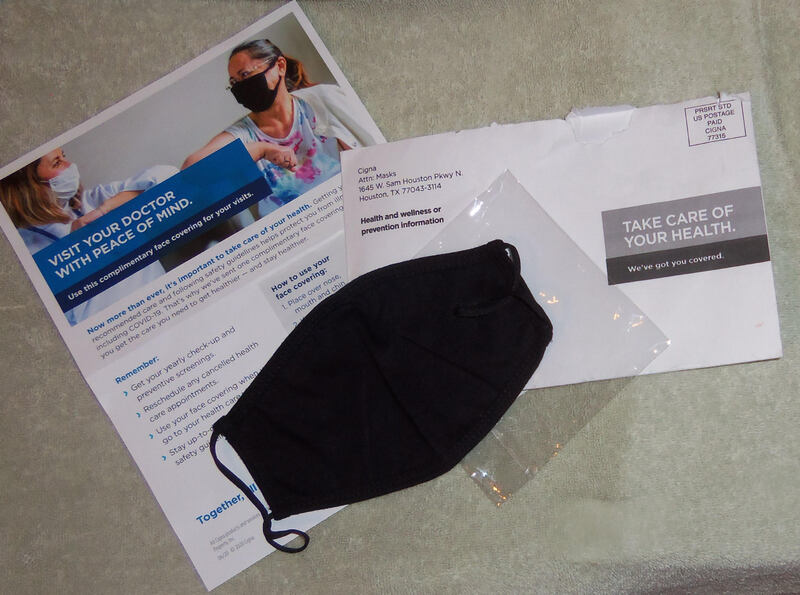 2020-08-07
2020-08-07Health Insurance Providers mailing reusable masks for medical appointments
On August 7, 2020 I received a message from a relative that their health insurance company had mailed them a small envelope with a cloth mask. At the time in Oklahoma, masks were still fairly difficult to find in stores and reusable masks were still available mostly online at considerable costs. The elderly relative said that her and her husband were told to use these if they went to a doctor's appointment or to a hospital. The pamphlet also advised them on the best way to wash and dry the mask for further use. This is something that seems like a small cost to the company, but could benefit everyone if it helped prevent people from getting sick, especially from COVID-19. -
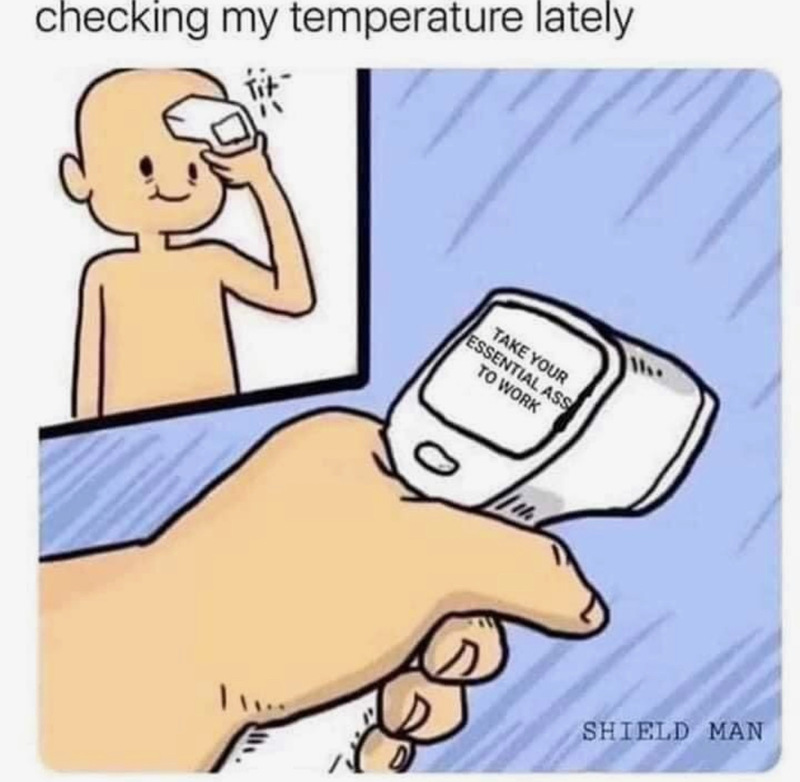 2020-08-16
2020-08-16Nurse Meme
This is a meme that was sent around the COVID unity among the nurses that my sister shared with me. I thought it was a funny way the nurses make the best of their situation and try to laugh whenever they can. -
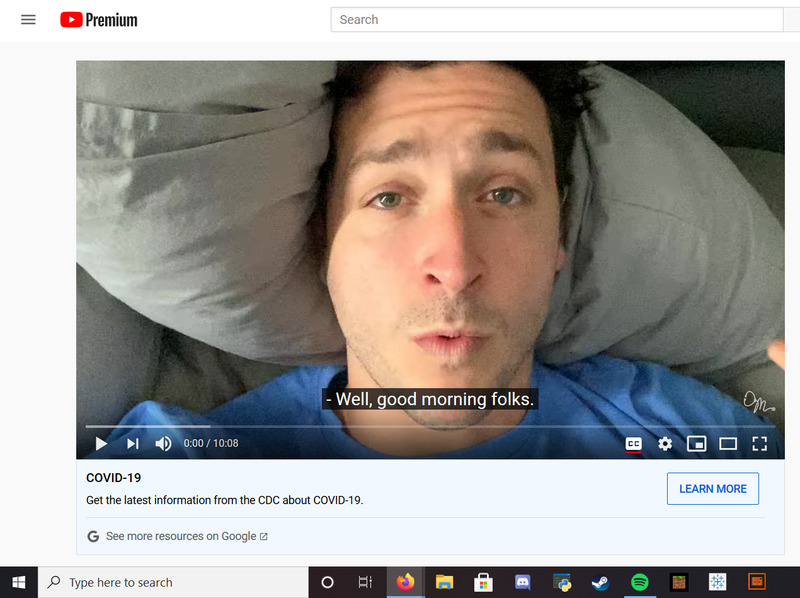 2020-10-20
2020-10-20A Day In The Life Of COVID-19
The main reason why I chose this piece of media is that I wanted to learn more about the daily life of nurses, doctors, and other healthcare workers. With both of my parents working in a healthcare setting, with my father as a nurse and my mother as a receptionist, it is important for me to understand what my parents deal with. I find this video to be extremely useful in becoming more aware of how government facilities are adapting to the virus, the daily life of healthcare workers and it gives me an overview of what I can possibly be doing in the future as a career. One precautionary action that the government has taken is an increase in virtual contact in order to prevent physical contact. In the vlog, Doctor Mike explains his hospital’s new “virtual patient visits”. This exhibits the government’s underlying guidelines (The CDC) about preventing the spread of the virus by limiting person to person contact. -
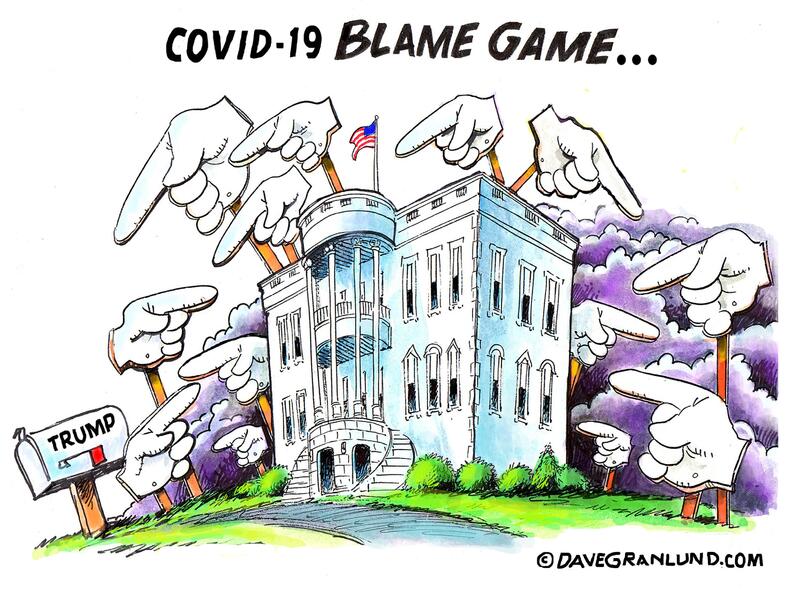 2020-10-19
2020-10-19A Government Against It's People
Finding any type of media that will accurately show what little the government has done and the lack of support the people of America have is unbelievably easy. In fact, I had a hard time choosing between which cartoon illustration was better. I knew our government wasn’t perfect, but it wasn’t until Donald Trump being elected and the coronavirus pandemic hitting our homes did I realize how terrible things really are. These cartoons depicted so well how our government has harmed us more than helped us. The dangerous lies told by our own president and how the government won't take responsibility. When corona made its way to the U.S it was deemed unserious. On March 11th, 2020, President Trump said, “The vast majority of Americans, the risk is very, very low.” At that time there were 1,105 cases and 33 deaths documented in the U.S. The next day my highschool as well as every other school within the country closed down as an “extra week of spring break” due to the virus. This “break” soon became eight months and in the U.S alone there are now 8,128,524 ( plus 47,035 new) cases with 218,986 ( plus 475 new) deaths . The scare became real, people started stocking up leaving nothing for anyone else. We have almost 15 people in our home, it took my mom multiple trips to different stores in order to get the necessities for our family. You would think when a pandemic is spreading throughout people in the country you were placed in position to protect you’d address the problem seriously and work hard to find a solution. All Trump and our government has done was ignore the citizens deaths and provide false hope. What we did get was our president being sarcastic and telling us to inject lysol into our lungs. The citizen’s of America have seen other countries rise in numbers of coronavirus with us and then watch their governments actually handle the situation causing their numbers to decline while our numbers are still shooting through the roof. The panic of this virus does not even cross the mind of those who are rich, the group that our current president only cares about. They didn’t have to worry about medical bills in a country where the president doesn’t believe free healthcare is a human right because they know they are important in his eyes. At the end of this virus, it will be the stories from the one percent belittling the destruction of this virus rather than those who have actually suffered. America is running on ignorance right now. Our own president and government is not concerned with the health of the country. It is the government's job to protect and provide for its people, whether it be an outside threat or a threat within the country. When I look at those cartoons of Donald Trump and the coronavirus, it makes me remember how badly I want our country to actually function the way it is intended to. -
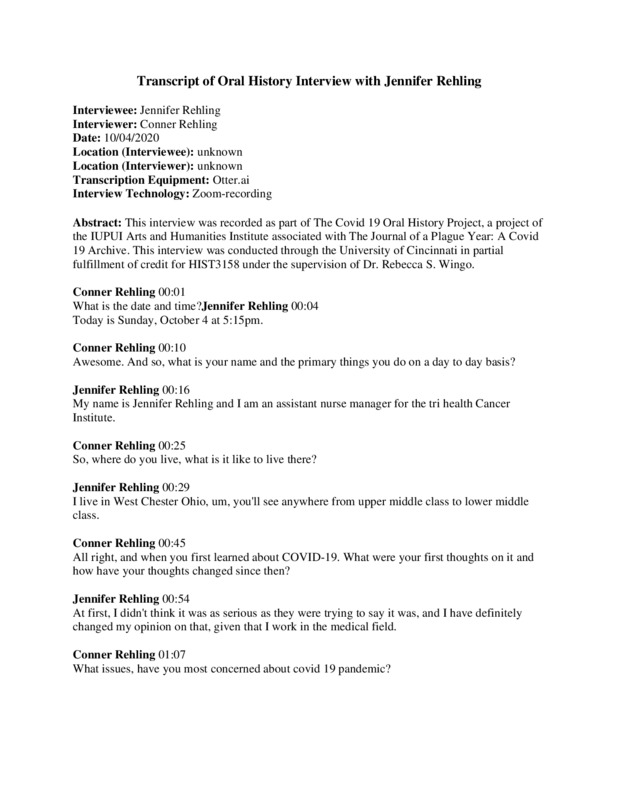 10/04/2020
10/04/2020Jennifer Rehling Oral History, 2020/10/04
This was an interview done with a nurse and the impacts she has seen in in work, life and community. -
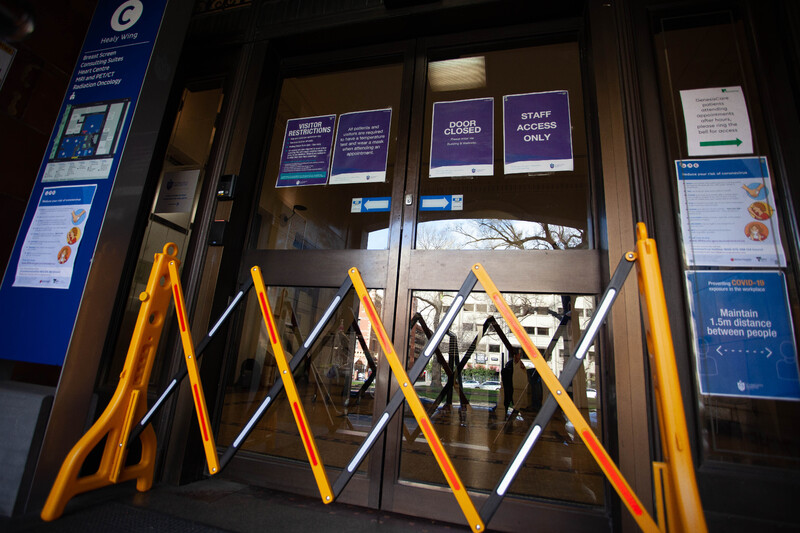 2020-07-14
2020-07-14Access restrictions during Victoria's second wave, St Vincent's Hospital Melbourne
A regular entrance to the hospital is closed and covered with posters with public health messages and information on access restrictions in response to Victoria's second wave of infections in July 2020. -
2020-04-15
Bay Area health care workers want more transparency about on-the-job coronavirus exposure
In 2020, there are a lot of secrets that are being kept from health care workers during the COVID-19 pandemic. Health workers have emphasized that they want to be immediately notified when they have come in contact with the coronavirus by patients, so they are able to get tested and stay safe away from others. However, many of them have not been notified- and that resulted them into testing positive for the coronavirus. This is extremely important to talk about because without health care workers, the pandemic would be much more out of control than how it is now. They put their lives at risk to help patients who have the coronavirus. If more and more workers are in the dark to whether a patient they have worked with has COVID, then there were be less health care workers available at hospitals for assistance. -
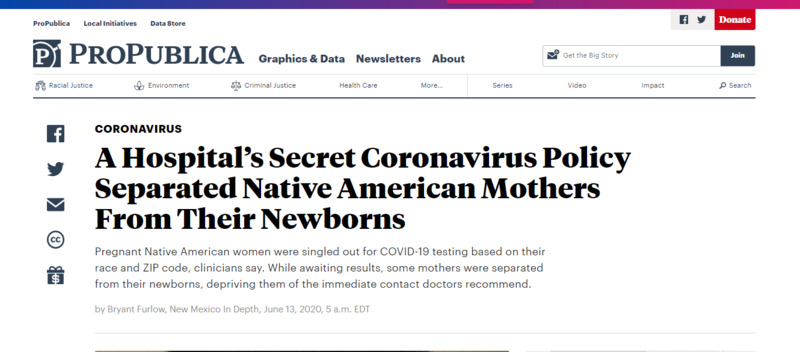 2020-06-13
2020-06-13Lovelace Hospital's Secret Coronavirus Policy
Lovelace Women’s Hospital in Albuquerque, New Mexico implemented a secretive policy that racially profiled Native American mothers. As expecting mothers who “looked” Native were admitted into the hospital, staff would compare their area codes to a list of zip codes belonging to Native lands such as Reservations or Pueblos. After being identified as “a person under investigation for COVID-19”, mothers were often misled or were forced into signing a wavier that gave permission for hospital staff to remove the newborns from their parents after birth. The families were only reunited once the pending coronavirus test results came back negative. Test results took up to three days to come in, thus leaving the mothers in fear and uncertainty about the wellbeing of their child. Lovelace, Native American, mothers, healthcare, newborns, separation, New Mexico indepth, ProPublica, racial profiling, New Mexico -
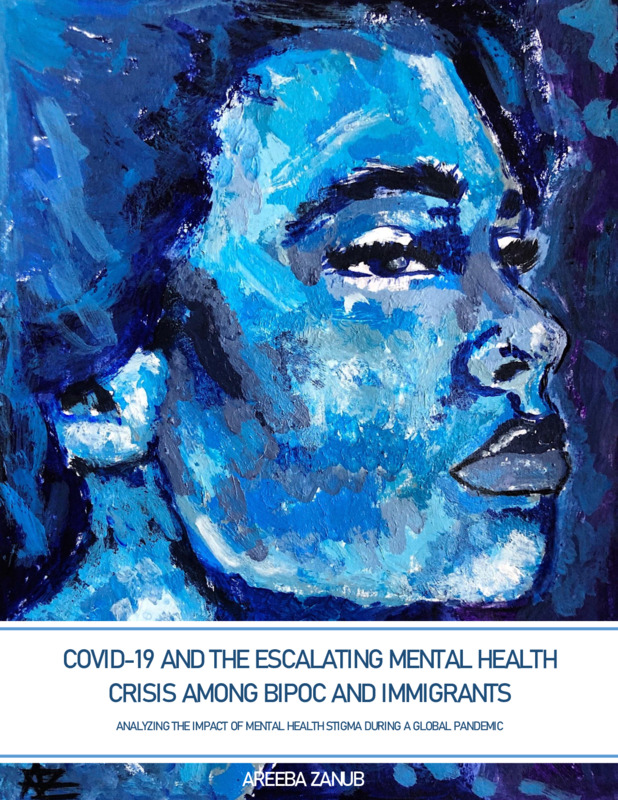 2020-08
2020-08COVID-19 AND THE ESCALATING MENTAL HEALTH CRISIS AMONG BIPOC AND IMMIGRANTS
The purpose of “COVID-19 and the Escalating Mental Health Crisis among BIPOC and Immigrants” is to analyze the already existing socioeconomic conditions in BIPOC and immigrant communities that perpetuate mental health stigma and are also causes for the rising mental health crisis during the COVID-19 pandemic. The research project aims to investigate generational trauma and its correlation to the pressurizing notion of the ‘essential worker,’ how the silence of trauma creates stigma, and the lack of representation and affordable mental health resources for low-income BIPOC and immigrants. -
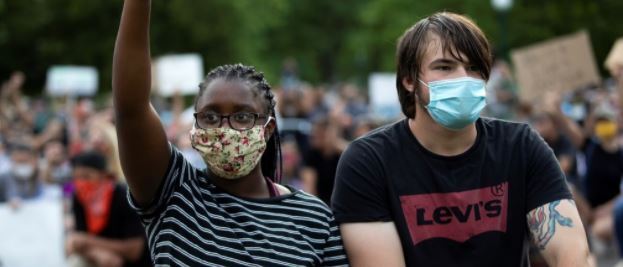 2020-09-08
2020-09-08Disconnect from our Core Values
This assignment is part of the American Studies classes at California High School in San Ramon, California. -
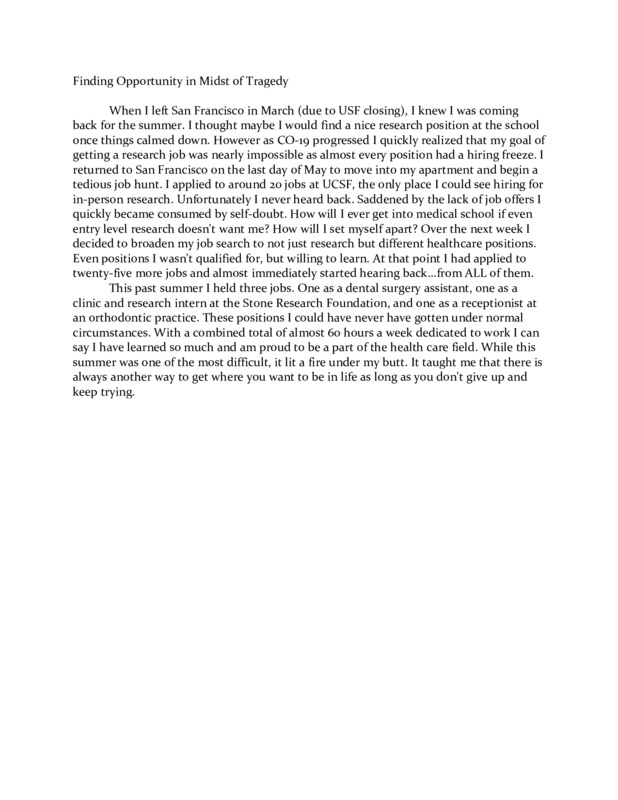 2020-06-09
2020-06-09Finding Opportunity in Midst of Tragedy
When I left San Francisco in March (due to USF closing), I knew I was coming back for the summer. I thought maybe I would find a nice research position at the school once things calmed down. However as CO-19 progressed I quickly realized that my goal of getting a research job was nearly impossible as almost every position had a hiring freeze. I returned to San Francisco on the last day of May to move into my apartment and begin a tedious job hunt. I applied to around 20 jobs at UCSF, the only place I could see hiring for in-person research. Unfortunately I never heard back. Saddened by the lack of job offers I quickly became consumed by self-doubt. How will I ever get into medical school if even entry level research doesn't want me? How will I set myself apart? Over the next week I decided to broaden my job search to not just research but different healthcare positions. Even positions I wasn't qualified for, but willing to learn. At that point I had applied to twenty-five more jobs and almost immediately started hearing back...from ALL of them. This past summer I held three jobs. One as a dental surgery assistant, one as a clinic and research intern at the Stone Research Foundation, and one as a receptionist at an orthodontic practice. These positions I could have never have gotten under normal circumstances. With a combined total of almost 60 hours a week dedicated to work I can say I have learned so much and am proud to be a part of the health care field. While this summer was one of the most difficult, it lit a fire under my butt. It taught me that there is always another way to get where you want to be in life as long as you don't give up and keep trying. -
2020-08-24
Everybody has a plan until they don't
I am finally returning to college, but certainly not under the circumstances I anticipated. I am already adjusting from a different major, but could have never imagined the added stress that this pandemic has brought. My family works in healthcare, so I considered myself generally aware of virology and therefore healthy practices to keep myself safe. However, I had no idea the measures that needed to be taken to ensure minimal spread. This is especially true of a college campus, which I haven't found myself on in several years. There is absolutely no reason to politicize this, we are all in this together. -
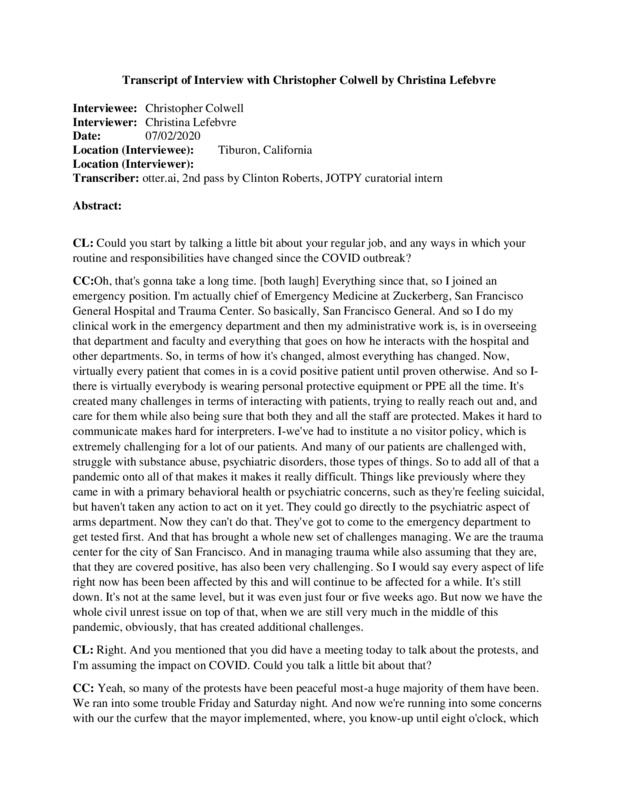 06/02/2020
06/02/2020Christopher Colwell Oral History, 2020/06/02
Interview with Dr Christopher Colwell, Chief of Emergency Medicine at Zuckerberg, San Francisco General Hospital and Trauma Center by interviewer Christina Lefebvre. Dr. Colwell speaks about the changes in his daily work activity and the obstacles of hospitals to respond to protests and a pandemic. He also shares his thoughts on how the pandemic has altered the practices and routines of medical facilities to maintain safety for patients and healthcare workers. -
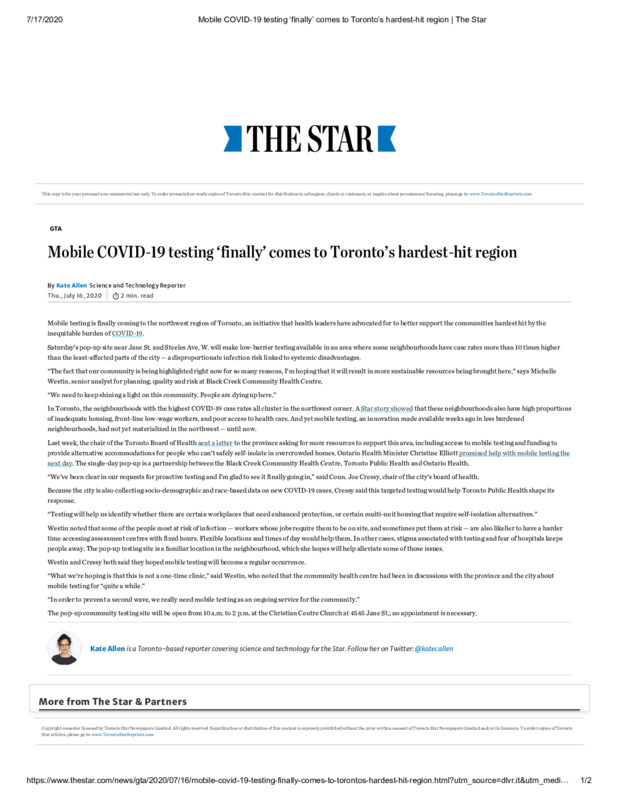 2020-07-16
2020-07-16Mobile COVID-19 testing ‘finally’ comes to Toronto’s hardest-hit region
"Saturday’s pop-up site near Jane St. and Steeles Ave. W. will make low-barrier testing available in an area where some neighbourhoods have case rates more than 10 times higher than the least-affected parts of the city — a disproportionate infection risk linked to systemic disadvantages." -
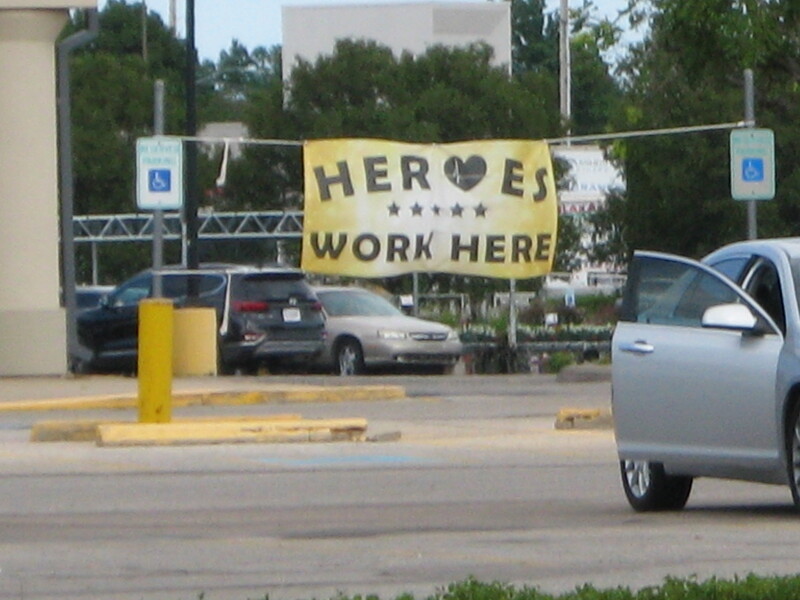 2020-07-09
2020-07-09Wichita's Healthcare Heroes
This banner honors the work performed by the doctors, nurses, and staff of the west Wichita Wesley Medical Center Emergency Room at 13th and Tyler Road. Signs like these proved fairly common across the city, therefore adding to the wide variety of expressions of gratitude displayed across the world for those in the medical professions who have dealt with COVID-19's harsh reality. Nonetheless, at the time this photograph was taken, Sedgwick County announced that its hospital space and ICU availability was beginning to encounter greater stress. After a hasty re-opening and a lack of political will to enforce and maintain mitigation measures, COVID-19 cases surged across the state, with patients from the county and surrounding rural areas lacking direct access to medical facilities being brought to Wichita-area hospitals for treatment. -
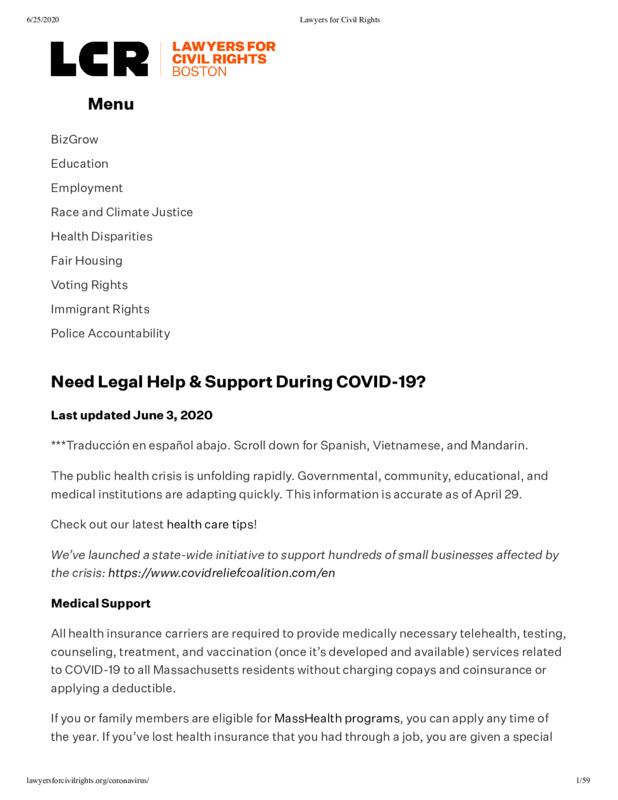 2020-06-03
2020-06-03Lawyers for Civil Rights Boston, COVID Resources
Lawyers for Civil Rights Boston offer resources for legal, medical, unemployment, housing, and economic support on their COVID response webpage . This document is in English and the site also offers translations in Spanish, Mandarin, and Vietnamese. While the world shut down for the pandemic, ICE continued to detain and deport immigrants here in the US, and the Black Lives Matter movement's response to police brutality sparked a number of arrests. Boston's Lawyers for Civil Rights organization has continued to offer legal support for those in need and has kept a running page of legal updates. -
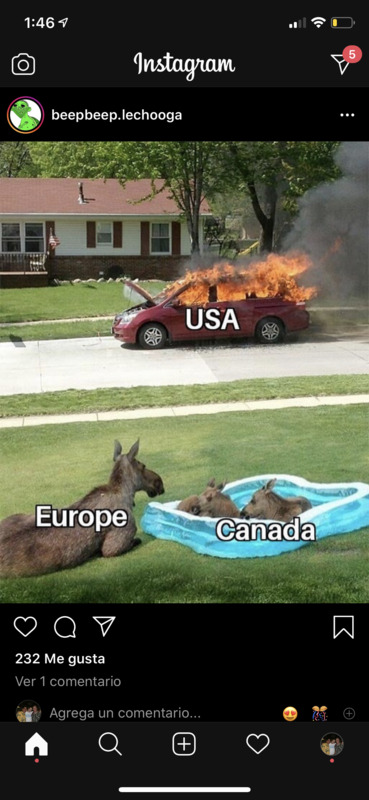 2020-06-08
2020-06-08Is the United States Doing Ok?
This meme highlights a feeling that I, and many friends and colleagues, are going through: what the heck is the US doing right now? We seem to have given up on trying to handle coronavirus. While that is bad by itself, at the same time we also seem to be in the middle of a racial reckoning that is directly tied into the pandemic. Questions of healthcare, liberties, and the ability to peacefully gather are all coming to the forefront as the average citizen tries to make sense of this all. -
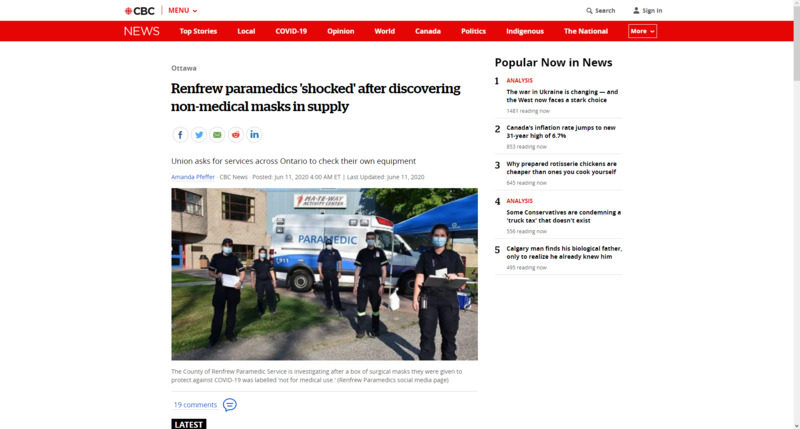 2020-06-11
2020-06-11Renfrew paramedics 'shocked' after discovering non-medical masks in supply
News story about non-medical masks discovered amongst the supply provided to Renfrew County paramedics and the resulting need for extensive Covid-19 testing of paramedics and those who had used the ambulance service during the period when the masks were in circulation. The incident serves as an example of the trust that equipment, even when it is available, will protect workers and the public being broken. -
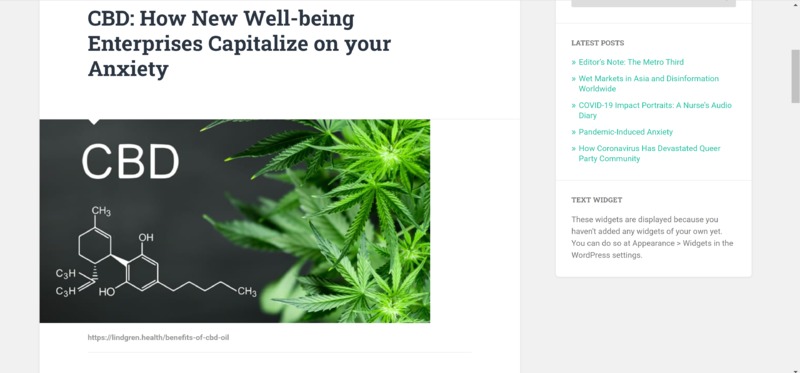 2020-04-30
2020-04-30CBD: How New Well-being Enterprises Capitalize on your Anxiety
"Ten years ago the only public displays of cannabis related usage would have been PSA’s warning against its harmful effects or perhaps a subway advertisement looking for people who are willing to participate in a study for addiction." This article describes CBD and cannabis use for health issues and concerns within NYC and was written by a senior journalism student following a beat developed and thought about in terms of the "local" in a journalism course at Pratt Institute that was upended by the pandemic. -
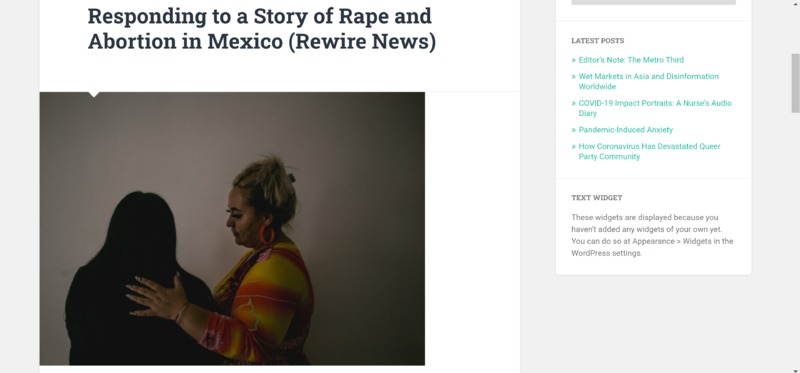 2020-04-23
2020-04-23Responding to a Story of Rape and Abortion in Mexico (Rewire News)
"Sixteen-year-old Patricia discovered she was pregnant after a taxi driver in her city of Guadalajara in Jalisco, Mexico, raped her." This article is responding to an article from Rewire News on a story of rape and abortion in Mexico, and was written by a senior journalism student following a beat developed and thought about in terms of the "local" in a journalism course at Pratt Institute that was upended by the pandemic. -
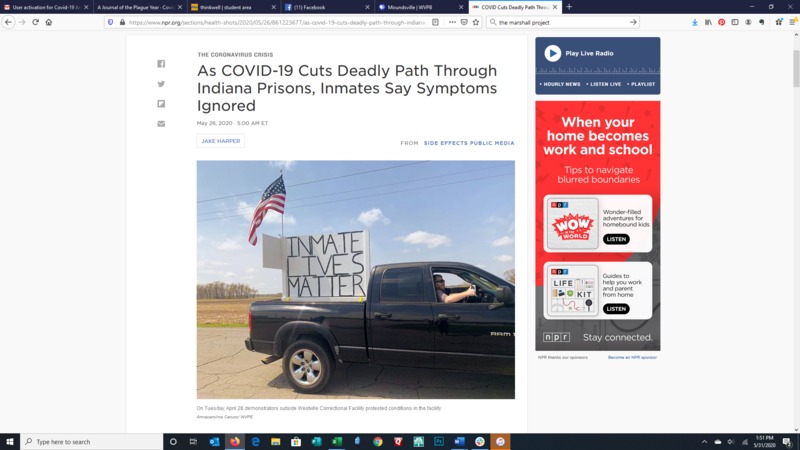 2020-05-26
2020-05-26Inmates claim their symptoms are ignored
In prison social distancing is impossible. Once covid enters a prison many become infected quickly. Inmates are saying their efforts to obtain medical care are being ignored and families are not being notified when their inmates become ill. Instead they are only being notified once their inmate has died from the virus.
